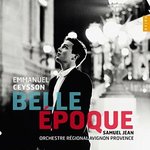|
Back
08/30/2015
“Belle Epoque”
Henriette Renié: Concerto for Harp and Orchestra in C minor
Théodore Dubois: Fantaisie for Harp and Orchestra
Gabriel Pierné: Concertstück for Harp and Orchestra in G-Flat major, Opus 39
Camille Saint-Saëns: Morceau de Concert for Harp and Orchestra, Opus 154
Emmanuel Ceysson (Harp), Regional Orchestra Avignon Provence, Samuel Jean (Conductor)
Recording: Auditorium du Grand-Avignon, Le Pontet, France (September 2014) – 66’57
naïve # V 5419 (Distributed by Naxos of America) – Booklet in French and English

   
This second album to be released by harpist Emmanuel Ceysson has cause for grand celebration. naïve’s collection is a rarified and fitting musical example of the spiritual optimism that pervaded Europe between 1871 and 1914. “Belle Epoque” fits neatly into the niche objectives of Le Palazetto Bru Zane by spotlighting peripheral compositions and digressions into sub-specialties of more familiar French composers. Just as engaging as it is concise, the Ceysson reading is a ‘must visit.’
As a student of Théodore Dubois, it comes as no surprise to hear Henriette Renié’s Concerto in C minor with stately structure. Emmanuel Ceysson illuminates the woman’s virtuosities by insistently plucking away at the chromatic harmonies with variant degrees of approach to reflect each of the piece’s four movements. Not to be outdone by precision muffles found within the opening “Allegro risoluto”, Ceysson’s melodramatic runs cascade with equally convincing drama. Renié had a brilliant quality of extending notes into the lower registers while transparently transforming emotion in a tender second…Emmanuel Ceysson relinquishes timidity and strengthens the piece with occasional Maurice Ravel-like flourishes.
While Renié’s music gathered a sense of youthful radicalness, her friend and tutor, Théodore Dubois can be looked upon as the quintessential master of restraining classicism. His Fantaisie, well-structured and brimming with poetic splendor, was inspired by Renié’s 1901 Concerto. One of the most lyrically touching pieces, Mr. Ceysson remarks of Dubois by carefully selecting perfect timing of string tension to produce notes of unusual beauty and pensiveness.
For a man who painted with highly modernist impressions, Gabriel Pierné’s Concertstück begins with a cello entrée that slowly unfolds into distant yet melodic fragrances of a fleeting Debussy. Pierné’s single theme peels away into multiple extractions. Deep inside, Ceysson gathers stimulating inertia, exerting sublime arpeggios while electrifying with voluble harmonics. Those familiar with his ballet composition, Cydalise et le chèvre-pied (Read here) will find the same sense of theatrical suspense entrenched inside Concertstück that Emmanuel Ceysson translates with exceptional perspective.
Upon hearing the initial grandiloquent bars of Morceau de concert, Saint-Saëns will immediately come to mind. Ceysson has no trouble convincing the listener of Saint-Saëns’ intended iridescent perlé texture. Inside the framing is a plenteous bowl of shimmering glissandi and majestic scaling. Constructed in a variant tableaux of sorts, the Morceau de concert gives Emmanuel Ceysson a final opportunity to unlock all that the harp has to offer by way of technique, approach, dynamics and richness. The Ceysson triplets are stellar.
Samuel Jean politely transcribes orchestral balance without overspinning or undermining the star instrument. Shining with musical respectability, “Belle Epoque” is a ‘thumbs-up’ proven winner. Highly recommended.
Works by Théodore Dubois
Palazzetto Bru Zane Website
Christie Grimstad
|